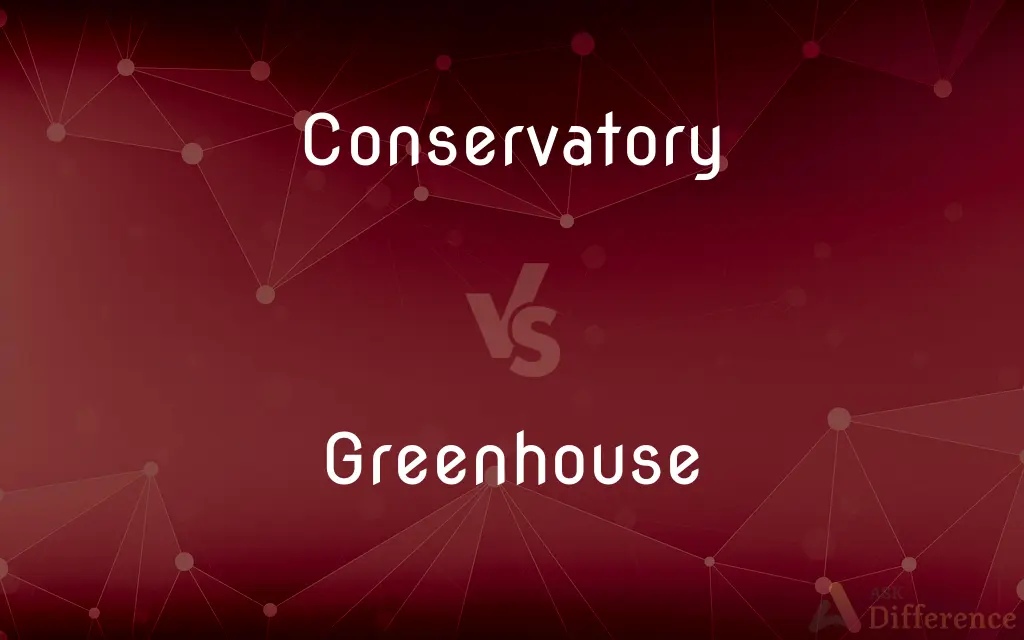Conservatory vs. Greenhouse — What's the Difference?
By Fiza Rafique & Urooj Arif — Updated on April 21, 2024
Conservatories are designed as extensions of living spaces with glass structures, often elegant and attached to homes, while greenhouses are primarily utilitarian structures aimed at protecting plants and optimizing growth.

Difference Between Conservatory and Greenhouse
Table of Contents
ADVERTISEMENT
Key Differences
Conservatories are typically part of a home, serving as additional living spaces with extensive glass panels and aesthetic designs. These structures are often used for relaxation or entertainment purposes, featuring comfortable seating and decorative plants. On the other hand, greenhouses are stand-alone structures specifically designed for growing plants. They prioritize functionality over aesthetics, with a focus on creating an optimal environment for plant health and productivity, often featuring systems for temperature and humidity control.
The architectural style of conservatories often complements the main residence, incorporating elements like ornate detailing and customized finishes. They are built to blend seamlessly with the home, enhancing its overall value and appeal. Whereas greenhouses are usually constructed with practical materials like plastic or glass that maximize light penetration and heat retention. They are less about looks and more about practicality, often situated in less visible areas of a property.
Conservatories may be equipped with climate control systems similar to the rest of the home, such as heating or air conditioning, making them comfortable year-round. Greenhouses, however, typically utilize specialized environmental systems designed for gardening, such as ventilation fans and heating mats, which are more utilitarian and focused on the needs of the plants rather than human comfort.
The usage of a conservatory often extends beyond plant cultivation; these spaces are frequently used for dining, lounging, or as a sunroom. Greenhouses are dedicated spaces for cultivating a wide variety of plants, including vegetables, flowers, and herbs, focusing on plant protection and propagation rather than multi-purpose use.
While conservatories are often subject to the same building codes and regulations as the main house, requiring permits and adherence to residential construction standards. Greenhouses are typically subject to different, often less stringent, building standards, as they are considered agricultural or horticultural structures.
ADVERTISEMENT
Comparison Chart
Purpose
Living space, aesthetic appeal
Plant cultivation, environmental control
Construction
Glass, aligned with home aesthetics
Glass or plastic, functional design
Location
Attached to home, visible
Separate, often less visible
Climate Control
Residential systems (heating, cooling)
Gardening systems (ventilation, heating mats)
Usage
Multi-purpose (relaxation, dining)
Dedicated to plant growing
Compare with Definitions
Conservatory
A glass building attached to a house, used as a sunroom or for growing plants.
The conservatory at their home offers a beautiful view of the garden.
Greenhouse
A structure with walls and roof made chiefly of transparent material, such as glass, in which plants requiring regulated climatic conditions are grown.
They use the greenhouse to grow vegetables year-round.
Conservatory
A building or room having glass or tarpaulin roofing and walls used chiefly for growing plants.
The large conservatory houses an impressive collection of tropical plants.
Greenhouse
A glass building in which plants are grown that need protection from cold weather.
The school's greenhouse is used by the biology class for experiments.
Conservatory
A structure with a glass roof and walls, used as a greenhouse or a sun parlor.
They converted the old conservatory into a cozy lounge for guests.
Greenhouse
A building with a roof and sides of glass, used for growing plants under controlled conditions.
Their greenhouse is equipped with advanced systems for temperature and humidity control.
Conservatory
An elegant glasshouse attached to a residence, used for recreation or ornamental display.
The estate features a Victorian-style conservatory that is a major attraction.
Greenhouse
A structure primarily made of glass or plastic where plants are cultivated in a controlled environment.
He built a small greenhouse in his backyard to start seedlings early in the spring.
Conservatory
A room with walls and ceilings made mainly of transparent material, often attached to a house.
Their new home has a conservatory where they enjoy breakfast in natural light.
Greenhouse
A building designed to optimize plant growth, protect from excessive cold or heat.
Their new greenhouse uses solar panels to maintain an ideal temperature for orchids.
Conservatory
A greenhouse, especially one in which plants are arranged aesthetically for display, as at a botanical garden.
Greenhouse
A greenhouse (also called a glasshouse, or, if with sufficient heating, a hothouse) is a structure with walls and roof made chiefly of transparent material, such as glass, in which plants requiring regulated climatic conditions are grown. These structures range in size from small sheds to industrial-sized buildings.
Conservatory
A school for the study of performing arts or fine arts, especially music.
Greenhouse
A glass building in which plants that need protection from cold weather are grown.
Conservatory
Having the quality of preserving from loss, decay, or injury.
Greenhouse
A structure, primarily of glass or sheets of clear plastic, in which temperature and humidity can be controlled for the cultivation or protection of plants.
Conservatory
(rare) Relating to conservation.
Greenhouse
(Slang) A clear plastic bubble or shell covering part of an aircraft.
Conservatory
(obsolete) That which preserves from injury.
Greenhouse
A building used to grow plants, particularly one with large glass windows or plastic sheeting to trap heat from sunlight even in intemperate seasons or climates.
Conservatory
A storehouse.
Greenhouse
The glass of a plane's cockpit.
Conservatory
A large greenhouse or hothouse for the display of plants
Greenhouse
(medicine) A structure that shields the operating table to protect against bacteria.
Conservatory
A glass-walled and -roofed room in a house
Greenhouse
(climatology) A hot state in global climate.
Conservatory
A school of music or drama
Greenhouse
(transitive) To place (plants) in a greenhouse.
Conservatory
Having the quality of preserving from loss, decay, or injury.
Greenhouse
To nurture in order to promote growth.
Conservatory
That which preserves from injury.
Greenhouse
A house in which tender plants are cultivated and sheltered from the weather.
Conservatory
A place for preserving anything from loss, decay, waste, or injury; particulary, a greenhouse for preserving exotic or tender plants.
Greenhouse
A building with glass walls and roof; for the cultivation and exhibition of plants under controlled conditions
Conservatory
A public place of instruction, designed to preserve and perfect the knowledge of some branch of science or art, esp. music.
Greenhouse
Of or relating to or caused by the greenhouse effect;
Greehouse gases
Conservatory
The faculty and students of a school specializing in one of the fine arts
Conservatory
A schoolhouse with special facilities for fine arts
Conservatory
A greenhouse in which plants are arranged in a pleasing manner
Common Curiosities
What is the primary purpose of a greenhouse?
To create a controlled environment optimized for the growth and protection of plants.
Do conservatories need special building permits?
Yes, like any home extension, conservatories usually require building permits and must adhere to local building codes.
What is the primary purpose of a conservatory?
To provide a pleasant, light-filled space for relaxation and social activities, often attached to a home.
Can a greenhouse be attached to a house like a conservatory?
While less common, some greenhouses are attached to homes but are primarily built as separate structures.
Is a conservatory more expensive than a greenhouse?
Generally, yes, because conservatories are designed to be aesthetic extensions of a home and often use more expensive materials.
What type of climate control is common in greenhouses?
Greenhouses often have specialized systems for ventilation, heating, and sometimes cooling, to maintain optimal plant growth conditions.
Can a conservatory be used to grow plants?
Yes, many conservatories serve dual purposes for both relaxation and cultivating ornamental plants.
Are greenhouses always made of glass?
No, greenhouses can also be made of other transparent materials like plastic, which are more cost-effective and durable.
What is the typical location for a greenhouse on a property?
Greenhouses are usually located in less visible areas of a property, where they can maximize light exposure and are conveniently close to water sources.
Are conservatories heated?
Yes, conservatories are often heated as part of the home’s heating system to be comfortable throughout the year.
What makes greenhouses ideal for plant cultivation?
Their design to maximize sunlight and control environmental conditions makes them ideal for plant cultivation.
What kinds of plants are typically grown in a conservatory?
Ornamental plants, citrus trees, and sometimes herbs are popular choices for conservatories.
Can a greenhouse be used year-round?
Yes, with proper heating and environmental controls, a greenhouse can be used to grow plants year-round.
What is the environmental impact of building a conservatory versus a greenhouse?
Building a conservatory may have a larger environmental impact due to the use of more materials and energy, especially if it is heated or cooled as part of the home.
How do the costs of maintaining a conservatory compare to a greenhouse?
Maintaining a conservatory can be more expensive due to its integration with the home's aesthetics and climate control systems.
Share Your Discovery

Previous Comparison
Neuroatypical vs. Neurotypical
Next Comparison
Overtake vs. UndertakeAuthor Spotlight
Written by
Fiza RafiqueFiza Rafique is a skilled content writer at AskDifference.com, where she meticulously refines and enhances written pieces. Drawing from her vast editorial expertise, Fiza ensures clarity, accuracy, and precision in every article. Passionate about language, she continually seeks to elevate the quality of content for readers worldwide.
Co-written by
Urooj ArifUrooj is a skilled content writer at Ask Difference, known for her exceptional ability to simplify complex topics into engaging and informative content. With a passion for research and a flair for clear, concise writing, she consistently delivers articles that resonate with our diverse audience.
















































